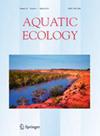Top-down control: microzooplankton grazing impact on phytoplankton biomass and community composition in a tropical monsoon driven lagoon, Chilika, India
Abstract
Dilution experiments were conducted to estimate the microzooplankton (MZP) grazing rate and phytoplankton growth rate in Chilika Lagoon during the summer and winter seasons. The phytoplankton growth rate ranged between 0.71 ± 0.11–2.86 ± 0.10 day–1 and 0.62 ± 0.01–1.45 ± 0.02 day–1, whereas MZP grazing rates ranged from 1.59 ± 0.11–2.92 ± 0.12 day–1 to 1.48 ± 0.05–2.15 ± 0.33 day–1 during the summer and winter seasons respectively. Experimental results showed that the phytoplankton growth rate was lower than the MZP grazing rate in both seasons, indicating constant grazing pressure on the prey community. Also, MZP was capable of grazing more than 100% of daily primary production and 46–95% of daily phytoplankton standing stock. The Southern Sector of the lagoon was under high grazing pressure due to low phytoplankton biomass and high MZP abundance during the study period. Grazing pressure was higher in the Central Sector and Outer Channel during the winter and in the Northern Sector (NS) during the summer. The observed results highlight MZP as a potential consumer for phytoplankton primary production. The positive correlation between phytoplankton growth rate and grazing rate (R = 0.820, P < 0.05) represents MZP as a major control of phytoplankton growth in both summer and winter. The high growth rate of phytoplankton during the summer season was balanced by the MZP grazing. All the sectors exhibited seasonal variations in grazing pressure depending on phytoplankton abundance and salinity conditions. From our study, we can conclude the top-down control of phytoplankton biomass by MZP in the Chilika Lagoon due to the high grazing rate.

 求助内容:
求助内容: 应助结果提醒方式:
应助结果提醒方式:


